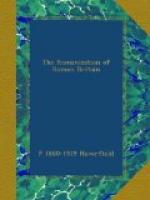[Illustration: Fig. 15. URNS FROM CASTOR, NOW IN PETERBOROUGH MUSEUM. (P. 41)]
[Illustration: FIG. 16. HUNTING SCENES FROM CASTOR WARE (ARTIS, DUROBRIVAE). (SEE PAGE 41.)]
[Illustration: FIG. 17. HERCULES RESCUING HESIONE. (From a piece of Castor ware found in Northamptonshire. C.R. Smith, Coll. Ant., vol. iv, Pl. XXIV.)]
A second instance may be cited, this time from sculpture, of important British work which is Celtic, or at least un-Roman (Frontispiece). The Spa at Bath (Aquae Sulis) contained a stately temple to Sul or Sulis Minerva, goddess of the waters. The pediment of this temple, partly preserved by a lucky accident and unearthed in 1790, was carved with a trophy of arms—in the centre a round wreathed shield upheld by two Victories, and below and on either side a helmet, a standard (?), and a cuirass. It is a classical group, such as occurs on other Roman reliefs. But its treatment breaks clean away from the classical. The sculptor placed on the shield a Gorgon’s head, as suits alike Minerva and a shield. But he gave to the Gorgon a beard and moustache, almost in the manner of a head of Fear, and he wrought its features with a fierce virile vigour that finds no kin in Greek or Roman art. I need not here discuss the reasons which may have led him to add the male attributes to a properly female type. For our present purpose the important fact is that he could do it. Here is proof that, once at least, the supremacy of the dominant conventional art of the Empire could be rudely broken down.[1]
[Footnote 1: For the details of the temple and pediment see Vict. Hist. Somerset, i. 229 foll., and references given there. I have discussed the artistic problem on pp. 235 and 236.]
A third example, also from sculpture, is supplied by the Corbridge Lion, found among the ruins of Corstopitum in Northumberland in 1907 (Fig. 18). It is a sculpture in the round showing nearly a life-sized lion standing above his prey. The scene is common in provincial Roman work, and not least in Gaul and Britain. Often it is connected with graves, sometimes (as perhaps here) it served for the ornament of a fountain. But if the scene is common, the execution of it is not. Artistically, indeed, the piece is open to criticism. The lion is not the ordinary beast of nature. His face, the pose of his feet, the curl of his tail round his hind leg, are all untrue to life. The man who carved him knew perhaps more of dogs than lions. But he fashioned a living animal. Fantastic and even grotesque as it is, his work possesses a wholly unclassical fierceness and vigour, and not a few observers have remarked when seeing it that it recalls not the Roman world but the Middle Ages.[1]
[Footnote 1: Arch. Aeliana, 1908, p. 205. I owe to Dr. Chalmers Mitchell a criticism on the truthfulness of the sculpture.]
[Illustration: FIG. 18. THE CORBRIDGE LION. (P. 43.)]




